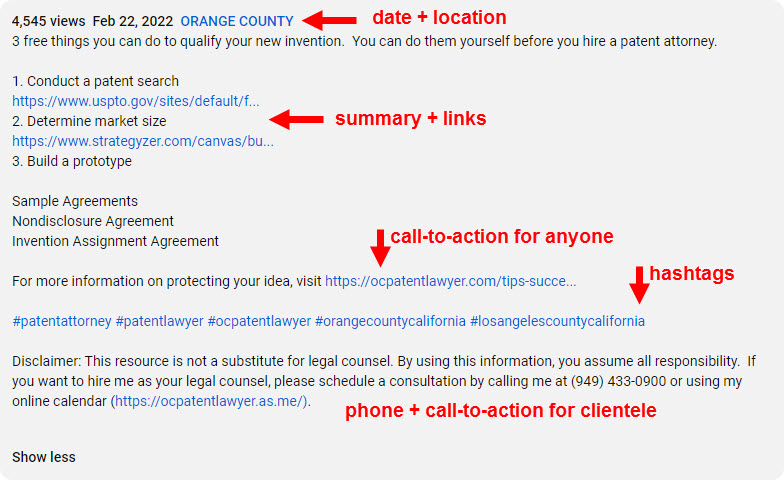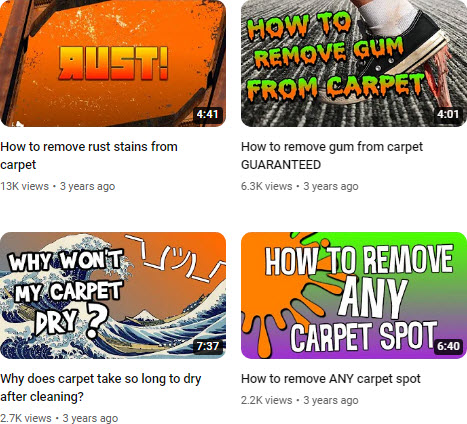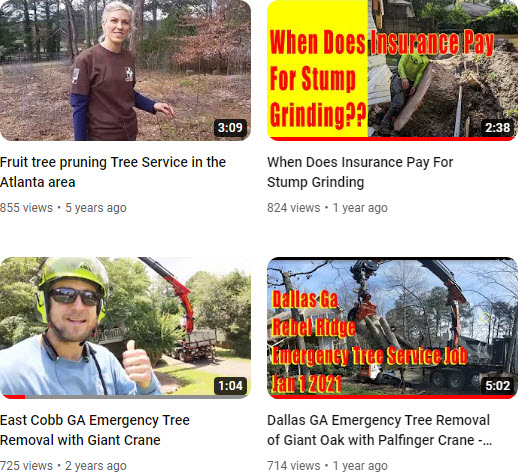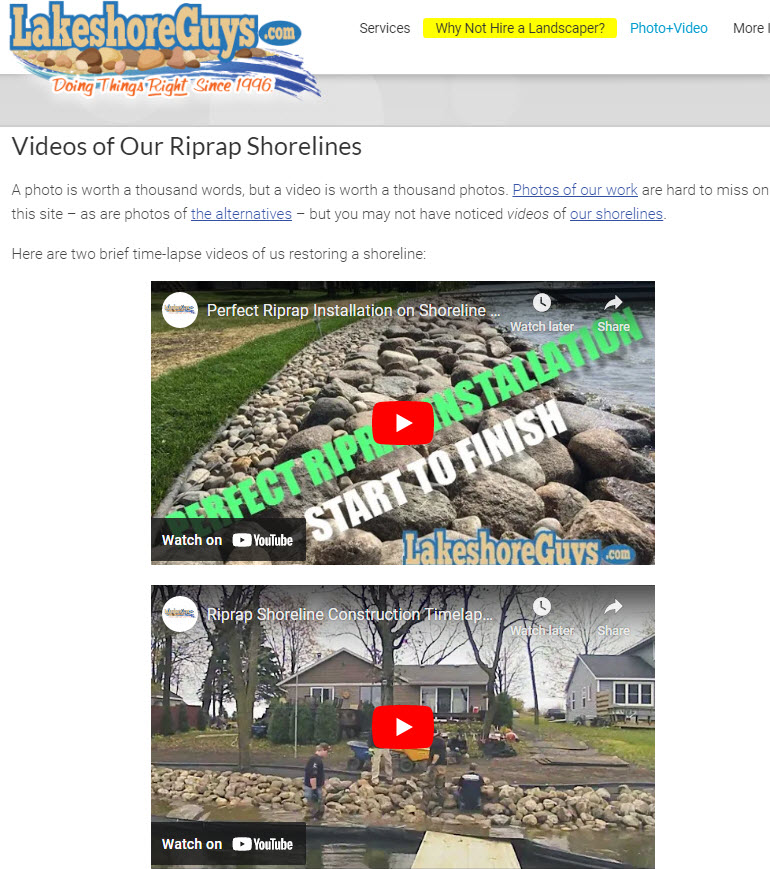
If you’re like me, you don’t obsess over YouTube or videos in general. Maybe it’s tough to do videos in your industry, and tougher in your particular situation. You may have your hands full with all of the other SEO and marketing stuff. You may not like handing over so much of your intellectual property to Google (and you’re not too interested in TikTok). Just the same, whenever you DO have some videos that you’ve sent off to YouTube Camp, you want to make sure they at least come home with some local rankings or other souvenirs in the backpack.
YouTube optimization is a lot like most other areas of SEO. For one thing, most of your rewards come from nailing the basics consistently. Also, it’s especially like local SEO in that the rankings are murky: Often you can’t tell how much any one action or ranking factor helps you, but you usually see a big difference when you hit the optimization from many angles. This post is about how you can do that – how you can get any YouTube efforts to pull your local visibility up.
I’m not saying that simply having YouTube videos help your rankings one pinch. I’ve never seen that they do. Nor am I saying that you should start doing videos if your local visibility is in terrible shape (you bigger fish to fry), or if your local SEO is dialed-in and generating great business, or if videos just aren’t your thing. All I’m saying is that some best-practices on videos can strengthen your local SEO in ways big and small.
So exactly how can strong video SOPs help your local SEO?
- Some videos can rank for local search terms. (Duh.)
- Some videos can rank in a specific area for non-location-specific search terms.
- They help you create more pages on your site, of the kind that can rank in the local organic results or pull you into the 3-pack.
- They can help you improve or interlink existing pages on your site, perhaps to the point that you get their rankings unstuck.
- If a video really has legs it may win you some good backlinks over time. (Of course, a lot of “ifs” determine how likely that is.)
- You’ll be more visible IN YouTube to the relatively few people who use YouTube to research and compare specific businesses (local and non-local).
- They can bring in more customers/clients/patients – people who in time may review you, give you occasion to produce more photos or videos, give you ideas for written content you might not have thought of, drive word-of-mouth and more brand-name searches for your business, etc.
Here I’d be remiss not to mention this 2013 post from the great Chris Silver Smith. I found it useful earlier in the game, and to date it’s one of the only posts specifically about YouTube for local SEO (and it’s the only solid one I’ve seen). Some of the specific steps have changed a bit since 2013, but the basics have stayed the same. You may want to read that post before digging into the checklist in my post, because Chris explains some things more than I will.
Anyway, I spend a good chunk of time helping some clients on YouTube, and have learned a few things along the way.
Below is a 38-point checklist that I suggest you stick to as much as you can, for as many videos as you can. Next to most of the checklist items is a little color commentary, but you can get just the checklist here. The checklist isn’t laid out sequentially, so you wouldn’t necessarily do item #5 before #35.
General
1. Is the topic highly specialized? That is, is it of great interest to relatively few people, or only to people in a certain location or area? If the topic is too broad, the video is less likely to rank, at least any time soon.
2. Do you have a version in another language, if you speak another language or can realistically produce a video in one? For instance, maybe the English-language version of the video won’t get much traction, but the Spanish-language one might.
3. Have you chopped out unnecessary footage so as to make the video as short as possible?
4. If it’s a longer video, have you chopped it up into shorter videos on specific topics and uploaded and optimized each shorter video? Think of the latter as chapters, and the former as the book. Perhaps the longer video is too broad to rank for much or to get lots of views, but the more-focused videos may rank for more-specialized terms, rack up more views, rank even better, get even more views, and so on. This approach usually is a good idea even when the “long” version is pretty brief (e.g. 10 minutes), but it’s almost obligatory if the long video is long.
Why do those steps matter? You can fine-tune a video, plaster it all over your site, and plug it on your social media accounts all day long, but if you get certain basics wrong you’re just polishing a pile of guano.
Title
Does the title of your YouTube video include a…
5. Question or implied question that a would-be customer/client/patient might type into Google?
6. Related question, related phrase, or synonym? (As space permits: you’ve got only 100 characters.)
7. Location? Either where your business is located, where the video was shot, the area where most of your viewers probably live or work, etc.
8. Mention of the news channel or other organization that shot the video, if applicable?
Why do those steps matter? The title of the video is a big influence on rankings, and even more so on who clicks, who bothers to watch, and who ends up liking the video enough to take some action that helps you. In the absence of other optimization or a crazy number of views that the video gets seemingly by accident (like if somehow it went “viral”), then the title is one of just a few ways Google can tell what the video about and whom it’s relevant to. Sometimes Google doesn’t have too much else to go on.
Description
Does the description of your YouTube video include a…
9. Couple of paragraphs (at least), or a transcript, to summarize what’s in the video?
10. Naked link to (at least) one relevant page, post, or other resource on your site?
11. Naked link to your homepage?
12. Brief description of your service area or a mention of your location?
13. NAP blob, if applicable?
14. Clear call-to-action geared toward potential customers/clients/patients?
15. Link to related videos you hope the viewer checks out?
16. Link to a version of the same video in a different language, if applicable?
17. Some hashtags, if applicable?

Why do those steps matter? Unlike in the “title” field, there’s a lot you can shoehorn into the description, and few limitations on it. It’s where YouTube/Google can really chow down on what you say about your video, and can square that with what YouTube understands from the audio of your video. So you want the description to reflect the subject matter of the video and maybe add some detail to it.
Of course, ou can take the description too far and lose viewers’ interest, though I doubt YouTube/Google would ding you in any way for that. The above-mentioned items are pretty easy to work into your description and still not have the whole thing run really long or be too flabby. If you just stick to the above points, your description will probably still seem businesslike and restrained.
Other fields
In the other fields that YouTube lets you customize for any given video, have you…
18. Added as many tags as you can in the “tags” field? Include individual keywords and longer search phrases that reflect the specific topics you touch on in the video, synonyms, relevant locations, your name or the name of your business, and anything else that seems relevant.
19. Have you renamed the raw video file to something relevant? No reason not to. You’d just need to do it before you upload the video to YouTube.
20. Specified the language of the audio?
21. Specified the language of the subtitles?
22. Specified the “Location” of filming, if applicable?
23. Specified the recording date?
Why do those steps matter? It’s safe to assume every YouTube setting is there for a reason. If it doesn’t factor into Google’s rankings outright, then it helps Google categorize your video a little more accurately or show it to specific people, or it tells viewers what to expect. Anything you can do to make your video a great fit in a specific niche – not to try to interest everyone everywhere – is usually worth doing. Punch a little below your weight class, at least at first.
Website leverage
On your website, have you…
24. Embedded every video on at least one page (or blog post)?
25. Embedded the most-relevant, most-urgent, or most-popular video(s) on critical pages of your site? (E.g. homepage, contact page, certain service pages, “areas served” page, etc.)
26. Embedded videos that are about or shot in in a specific city on the corresponding “city” pages?
27. Linked to your YouTube channel in at least a few noticeable spots, and encouraged visitors to watch more of your videos and to subscribe?
28. Created a main “Video Gallery” page, featuring all or most of your videos?
29. Created a page for each topic you’ve got a video on?
30. Put low-views videos higher up on the pages where you’ve embedded them?
Why do those steps matter? Perhaps it’s common knowledge, but I’ve found that the view count of a video is a huge determinant of how well it ranks, especially over the long haul. But then how’s it suppose to get a lot of views if it doesn’t rank for jack? You can see the chicken-or-the-egg conundrum.
Turns out the easiest (and I’d say best) way to build up the views over time is to build off of your existing site traffic. Presumably you have at least a little traffic. (And if you don’t, you probably shouldn’t be digging into YouTube SEO just yet.)
My advice is simple: go heavy on the YouTube embeds on your site. Embed your videos early and often. If your site’s already pretty visible but your videos aren’t, this will help the videos catch up. If your site isn’t too visible yet, either, both it and your videos should slowly float up together.
Troubleshooting
If your video hasn’t gotten much traction, have you…
31. Tried watching the videos on different devices and browsers?
32. Used a video-preview thumbnail that won’t scare viewers away?
33. Tried adding a call-to-action to get website visitors to watch the embedded video? As in, “Watch the 2-minute video below.”
34. Confirmed that the each page you’ve embedded the video on shows up as an indexed “Video Page” in Search Console?

35. Checked out others’ (especially competitors‘) videos on the topic and determined there isn’t an obvious “quick win” they’re taking advantage of that you’re not?
36. Tried linking to the video (where appropriate), in lieu of embedding the video on your site?
37. Given it a couple of months? Even if you’ve done most of steps I’ve recommended, your video may not see much action right away. Often it just takes time, as most things in SEO do.
38. Uploaded the raw video file to your Google Business Profile page (if appropriate)? That won’t help the YouTube video, but you will get a better sense how many would-be customers want to watch a video by you, and you’ll get some of them accustomed to watching your videos.
Why do those steps matter? You won’t always get a video to yield any candy after one whack at the piñata. Sometimes you need to take another swing at it. Troubleshooting is critical in most areas of local SEO – from figuring out your review- or link-earning strategy, to getting specific pages to perform better, to figuring out what just happened to your GBP page, and so on. YouTube SEO is no different. Even if you troubleshoot and do a round 2, a video still might not produce all you wanted it to, but it probably will produce more of what you want. Meanwhile, you can turn your attention other videos or other marketing-related chores.
Examples
Below are some examples of “local” businesses that have used videos effectively in at least one way or another. (Yes, some of these include my handiwork.)
One thing you’ll notice that most of videos aren’t “viral.” Not only is “viral” not the goal or the product of most effective YouTube work, but it also seldom helps your visibility or profitability in any describable way. The whole idea has always been overrated and overhyped.
The other thing you may notice is that none of these is a tourist destination, a famous restaurant, an institution, or in a glamorous industry. In other words, it’s hard to say, “Yeah, that’s easy for them to do, but what about everyday businesses run by everyday people?” These businesses wear different colors of collar, have different budgets and resources, and work in different areas. Yet their YouTube videos pull plenty of freight.
Carpet cleaning: youtube.com/@CitruScrubCarpetCleaning – citruscrub.com
Auto detailing: youtube.com/@detailgroove – r3detailing.com
Patent law: youtube.com/@ocpatentlawyer773 – ocpatentlawyer.com
Facial surgery: youtube.com/@dr.michelsiegel-facialplas8089 – houstonfaces.com
Ice dam removal youtube.com/@IceDamGuys – icedamremovalguys.com/videos
Shoreline restoration: youtube.com/@lakeshoreguys – lakeshoreguys.com/videos
Gutter guard installation: youtube.com/@gutterguardsdirect/videos – gutterguardsdirect.com/gutter-guard-challenge
Bankruptcy trustees: youtube.com/@hoyesmichalos/videos – hoyes.com
Test-prep tutoring: youtube.com/@VinceKotchian/videos – vincekotchian.com
Tree removal: youtube.com/@770arborist/videos – 770arborist.com/videos
—
Have you seen examples of local businesses in a pretty standard situation that seem extra visible because they’ve done very solid videos?
Any YouTube SEO / local SEO steps I left off of the checklist?
What’s worked (or not worked) for you?
Leave a comment!





